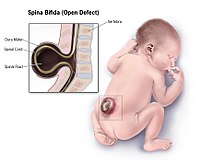
Photo from wikipedia
Supplemental Digital Content is available in the text. Background: Craniosynostosis following placement of a ventriculoperitoneal shunt for hydrocephalus has been sporadically described. The purpose of this investigation was to determine… Click to show full abstract
Supplemental Digital Content is available in the text. Background: Craniosynostosis following placement of a ventriculoperitoneal shunt for hydrocephalus has been sporadically described. The purpose of this investigation was to determine the general risk of developing craniosynostosis in this patient population. Methods: The authors retrospectively reviewed records and radiographs of infants who underwent ventriculoperitoneal shunt placement for hydrocephalus from 2006 to 2012. Recorded variables included date of shunt placement, demographics, comorbidities, cause of hydrocephalus, shunt type, and number of shunt revisions. Axial computed tomographic images obtained before and immediately after shunt placement and 2 to 4 years after shunt placement were evaluated by a panel of clinicians for evidence of craniosynostosis. Patients with preshunt craniosynostosis, craniosynostosis syndromes, or poor-quality computed tomographic images were excluded. Data were analyzed using STATA Version 15.1 statistical software. Results: One hundred twenty-five patients (69 male and 56 female patients) were included. Average age at shunt placement was 2.3 ± 2.58 months. Sixty-one patients (48.8 percent) developed craniosynostosis at a median of 26 months after shunt placement. Of these, 28 patients fused one suture; the majority involved the sagittal suture (n = 25). Thirty-three patients fused multiple sutures; the most common were the coronal (n = 32) and the sagittal (n = 30) sutures. Multivariable logistic regression identified older age at shunt placement and more shunt revisions as independent predictors of craniosynostosis. Shunt valve type was not significant. Conclusions: Craniosynostosis developed in nearly half of infants who underwent ventriculoperitoneal shunt placement for hydrocephalus. The sagittal suture was most commonly involved. The effect of suture fusion on subsequent cranial growth, shunt failure, or the development of intracranial pressure is unclear. CLINICAL QUESITON/LEVEL OF EVIDENCE: Risk, III.
Journal Title: Plastic and Reconstructive Surgery
Year Published: 2021
Link to full text (if available)
Share on Social Media: Sign Up to like & get
recommendations!